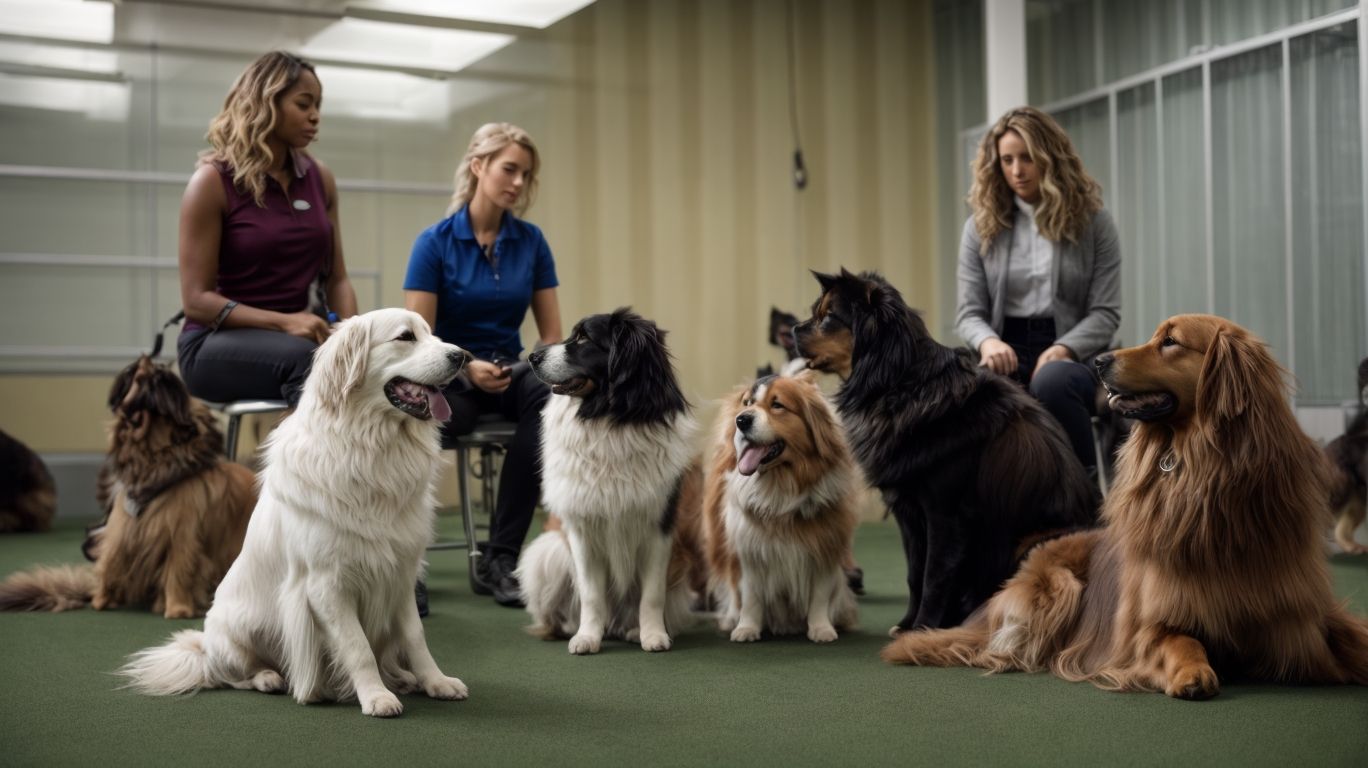
Essential Commands for Therapy Dogs: Training for Compassionate Canine Helpers
In today’s fast-paced world, the presence of therapy dogs has become increasingly prevalent in various settings, from hospitals and nursing homes to schools and workplaces. These specially trained canines provide invaluable support and comfort to individuals in need, offering a range of physical, mental, and emotional benefits.
In this comprehensive guide, we will delve into the world of therapy dogs, exploring their essential commands, the benefits they offer, and the process of training these compassionate canine helpers. Whether you’re considering getting involved in therapy dog work or simply curious about the impact these animals have, this article will provide you with the essential knowledge to understand and appreciate the vital role of therapy dogs in our society.
What Are Therapy Dogs?
Therapy dogs are specially trained canine helpers that provide essential emotional support and comfort to individuals in various settings, such as hospitals, nursing homes, schools, and rehabilitation centers.
They undergo rigorous training to develop the skills required for their role, including obedience, socialization, and the mastery of essential commands. This training enables them to remain calm in any environment and to interact with various people, showing empathy and understanding. Their compassionate nature allows them to form deep connections with those they help, contributing to the emotional well-being of individuals through their comforting presence and non-judgmental companionship.
These dogs have a remarkable ability to uplift spirits and bring a sense of ease and joy to those they interact with, making a positive impact on their emotional health.
What Are the Benefits of Therapy Dogs?
Therapy dogs offer a wide array of benefits, including emotional support, positive reinforcement, and valuable assistance in interventions and therapy work, showcasing their remarkable training techniques and skills in behavior modification.
Physical Benefits
The presence of a therapy dog can contribute to physical benefits for individuals, promoting health and wellness, and offering both physical and emotional support while facilitating the development of social skills.
Interacting with therapy dogs has been shown to reduce stress levels, decrease blood pressure, and lower heart rate. These physical benefits not only promote a sense of calm and relaxation but also contribute to overall improved cardiovascular health. The act of petting a therapy dog can release endorphins, the body’s natural feel-good hormones, which can help alleviate pain and provide a mood lift.
Therapy dogs help individuals engage in physical activities, such as walks and play, which in turn promote exercise and mobility, thus enhancing their physical well-being.
Mental Health Benefits
Therapy dogs play a crucial role in promoting mental health by offering stress relief, encouraging social interaction, and providing valuable emotional support to individuals in need.
Interacting with therapy dogs has been shown to reduce anxiety and lower cortisol levels, contributing to a more relaxed state of mind. Their presence can help facilitate social connections, as people often bond over their shared love for animals. Therapy dogs offer a sense of companionship and comfort, which can be particularly beneficial for those experiencing feelings of loneliness or isolation.
Research has also demonstrated that spending time with therapy dogs can release feel-good hormones, such as oxytocin, further enhancing emotional well-being.
Emotional Benefits
The presence of a therapy dog fosters emotional benefits by promoting bonding, nurturing empathy, and instilling a sense of responsibility, contributing to individuals’ overall well-being.
Interacting with a therapy dog has been scientifically proven to reduce stress and anxiety, as the unconditional love and non-judgmental nature of the canine companion can create a safe and calming environment. This can lead to an improved mood, increased self-esteem, and a greater sense of connection with others.
The interaction with therapy dogs can enhance empathy development by encouraging individuals to understand and respond to the needs of the animal, thereby fostering empathy and compassion. Taking care of a therapy dog can cultivate a sense of responsibility, as individuals learn to prioritize the well-being and needs of another living being, promoting a greater sense of purpose and fulfillment.
What Are the Essential Commands for Therapy Dogs?
Therapy dogs are trained to respond to essential commands that facilitate effective communication and bonding with their handler, requiring a foundation of trust, learning, and clear, concise commands.
Through consistent training, therapy dogs learn to understand and execute commands like ‘sit,’ ‘stay,’ ‘heel,’ and ‘come,’ which are crucial for guiding their behavior in various therapy settings. These commands not only allow the dog to provide comfort and support but also help in establishing a strong connection with their handler. By effectively responding to these commands, therapy dogs can create a safe and conducive environment, enabling better communication and interaction during therapy sessions.
Sit
The ‘Sit’ command is fundamental in therapy dog training, promoting obedience, responding to non-verbal cues, and exhibiting polite manners in various environments.
When a therapy dog can reliably sit on command, it sets the stage for effective intervention during therapy sessions. This simple but crucial skill enables the dog to remain calm and composed, making it easier for them to interact with individuals dealing with emotional or physical challenges.
By teaching the ‘Sit’ command, handlers can help their therapy dogs become more attuned to non-verbal cues, enhancing their ability to provide comfort and support to those in need.
Stay
The ‘Stay’ command is pivotal for therapy dogs to maintain composure and focus amidst distractions and in public access settings, showcasing their disciplined obedience training.
This command serves as a crucial element in a therapy dog’s ability to remain calm and attentive, particularly in environments where their presence might uplift individuals facing physical or emotional challenges. By mastering the ‘Stay’ command, therapy dogs can provide consistent care and support without getting distracted. This command enables them to exhibit impeccable public access behavior, ensuring that they can navigate crowded spaces or busy environments with poise and restraint.
Reinforcing the ‘Stay’ command reinforces the bond between the dog and their handler, emphasizing trust and reliability in their work.”
Come
The ‘Come’ command enables therapy dogs to respond promptly, showcasing effective recall and affirming their socialization skills during pet therapy interactions.
This command plays a vital role in ensuring that therapy dogs can be recalled in any situation, promoting their reliability during therapy sessions. It also helps in reinforcing positive socialization behaviors, allowing therapy dogs to interact confidently with patients and creating a conducive environment for emotional support.
The ‘Come’ command is an essential component of their training, as it fosters trust and responsiveness, which are crucial for successful pet therapy engagements. Through consistent practice of this command, therapy dogs can establish a strong connection with both their handlers and the individuals they interact with, ultimately enhancing the therapeutic impact of their presence.
Leave It
The ‘Leave It’ command instills essential impulse control in therapy dogs, setting clear boundaries and encouraging responsible behavior in various therapy settings.
This command trains therapy dogs to resist the temptation of engaging with distractions, whether it’s food, toys, or other animals, which is crucial in maintaining a calm and focused demeanor during therapy sessions. By teaching dogs to ‘leave it,’ handlers can ensure the safety and well-being of both the dogs and the individuals they are interacting with, promoting a secure and controlled environment for therapy activities.
This command reinforces the dog’s role as a support companion and fosters trust between the dog, the handler, and the individuals undergoing therapy.
Drop It
The ‘Drop It’ command enables therapy dogs to exhibit redirection and positive behavior through reward-based training, showcasing their responsive nature to positive reinforcement.
This command plays a vital role in redirecting a therapy dog’s focus from a potentially harmful or undesirable object to a more suitable alternative, ensuring the safety and well-being of those around them. By incorporating the ‘Drop It’ command into their training, therapy dogs learn to release items on command, thus fostering a sense of trust and reliability.
Utilizing reward-based training methods encourages the dog to respond eagerly to the ‘Drop It’ command, strengthening their bond with their handler and enhancing their overall effectiveness during therapy sessions.
Heel
The ‘Heel’ command teaches therapy dogs to maintain leash manners and work effectively with their handler teams, showcasing the importance of teamwork and cooperative behavior.
This command plays a crucial role in promoting discipline and focus in dogs during therapy sessions, enabling them to walk neatly alongside their handlers without pulling or wandering off. It fosters a strong sense of cooperation between the dog and the handler, strengthening their bond and trust. By adhering to the ‘Heel’ command, therapy dogs can navigate through crowded or distracting environments with ease, ensuring that they remain calm and attentive to the needs of those they are assisting.
Down
The ‘Down’ command encourages therapy dogs to exhibit relaxation and calm behavior during therapy sessions, highlighting their understanding of appropriate animal behavior in various settings.
This command plays a crucial role in creating a soothing and composed environment for the therapy sessions. By lying down, therapy dogs convey a sense of tranquility and submission, instilling a similar feeling in the individuals they are interacting with. It promotes a sense of security and comfort, especially for those undergoing emotional stress or trauma.
The ‘Down’ command helps prevent overexcitement and jumping, ensuring that the therapy dog maintains a respectful and non-intrusive approach, which is essential for fostering a positive therapeutic experience.
Wait
The ‘Wait’ command instills patience and reinforces public access behavior in therapy dogs, showcasing their disciplined obedience training and cooperative nature.
This command is pivotal in cultivating good behavior when interacting with varied environments. It enables therapy dogs to exhibit self-control, giving them the ability to wait calmly before proceeding, which is crucial in therapy settings. The ‘Wait’ command is essential in enhancing the safety and comfort of those being visited by the therapy dogs. By incorporating this command into their training, therapy dogs can provide a sense of predictability and reassurance to the people they are assisting.
Touch
The ‘Touch’ command encourages therapy dogs to engage in positive interaction, effective communication, and the development of social skills during therapeutic engagements.
This simple yet powerful command allows the therapy dog to make physical contact with individuals, promoting a sense of connection and comfort. By responding to the ‘Touch’ command, these dogs create a safe and nurturing environment for individuals, encouraging them to open up and interact.
Through this tactile interaction, therapy dogs help individuals build trust, improve their communication skills, and develop a sense of confidence, ultimately fostering a more positive and enriching therapeutic experience.
10. Quiet
The ‘Quiet’ command encourages therapy dogs to exhibit calmness and respond to non-verbal cues, contributing to stress relief and comfort in various environments.
This command is pivotal in ensuring that therapy dogs can create a soothing and peaceful atmosphere, especially in hospitals, nursing homes, and schools. By teaching them to be quiet on command, these dogs can offer support and comfort without being disruptive. The ability to respond to non-verbal cues enhances their communication with individuals who may not be able to verbally express their needs.
The ‘Quiet’ command plays a crucial role in the effectiveness of therapy dogs as facilitators of emotional well-being and relaxation.
11. Off
The ‘Off’ command enables therapy dogs to manage distractions and adhere to specific manners and rules, showcasing their understanding of appropriate behavior in diverse environments.
This command is crucial in reinforcing the dog’s obedience and self-control, which are essential traits for therapy work. By responding promptly to the ‘Off’ command, therapy dogs learn to resist the urge to engage with tempting stimuli, ensuring they can focus on their role effectively. It also promotes safer interactions with clients by preventing jumping or invasive behaviors.
The ‘Off’ command helps therapy dogs understand boundaries and respect personal space, contributing to their ability to provide comfort without unintentionally causing discomfort to others.”
How to Train a Therapy Dog?
Training a therapy dog involves a systematic approach that encompasses socialization, public access readiness, and the attainment of therapy dog certification, ensuring the dog’s preparedness for therapeutic work.
Socialization is a crucial aspect of therapy dog training, as it familiarizes the dog with various environments, people, and other animals. This helps the dog remain calm and relaxed in different settings, which is essential for its role in therapy.
Public access preparation involves teaching the dog to behave impeccably in public spaces, including following commands, remaining calm around distractions, and showing good manners.
Therapy dog certification validates that the dog meets the required standards and possesses the necessary temperament to interact with people in therapeutic settings.
Start with Basic Obedience Training
Initiating therapy dog training begins with basic obedience exercises, focusing on positive reinforcement techniques to instill fundamental behaviors and responses.
This approach is essential as it establishes a strong foundation for the dog’s behavior and paves the way for successful therapy work. Positive reinforcement techniques, such as treats, praise, and play, help create a positive association with desired behaviors, making the learning process enjoyable for the dog.
By starting with basic obedience exercises, the dog learns to respond to commands promptly, which is crucial for therapy dog work. It also builds trust and communication between the dog and the handler, laying the groundwork for more advanced training later on.
Socialize Your Dog
Socializing the therapy dog involves acclimating them to various environments, people, and stimuli under the guidance of an experienced animal behaviorist to ensure their readiness for public access and therapy work.
This acclimation process is critical as it helps the dog build confidence and resilience in diverse settings. The therapy dog is exposed to different sounds, textures, and interactions, preparing them to remain calm and focused amidst potential distractions. The animal behaviorist carefully monitors the dog’s reactions and provides tailored guidance to address any anxiety or apprehension. Through consistent exposure and positive reinforcement, the therapy dog becomes adept at bringing comfort and support to individuals in various therapeutic settings.
Teach Specific Commands for Therapy Work
Teaching specific commands tailored for therapy work enables dogs to provide targeted intervention and support during therapy sessions, exhibiting their readiness and competence in therapeutic engagements.
This specialized training equips therapy dogs to assist individuals in various therapeutic settings, allowing them to offer emotional support, calm anxiety, and provide a sense of comfort. By mastering commands specific to therapy work, these dogs can create a conducive environment for therapy sessions, thereby enhancing the overall therapeutic experience for individuals.
Their ability to respond to cues and commands with precision further demonstrates their capability to engage in complex therapeutic interventions.
Practice in Different Environments
Practicing in diverse environments allows therapy dogs to acclimate to potential distractions, navigate public access scenarios, and engage in supervised activities organized by therapy dog organizations.
This type of training is essential for therapy dogs as it prepares them to remain calm and focused amidst various stimuli and environments. Exposure to different settings enables them to develop the necessary skills to interact with different individuals in a professional and courteous manner. It helps in building their confidence and adaptability, making them more effective in their role as therapy dogs. Through this exposure, they learn to respond positively to diverse situations and provide comfort to those in need, whether in hospitals, schools, or other community settings.




No Comments